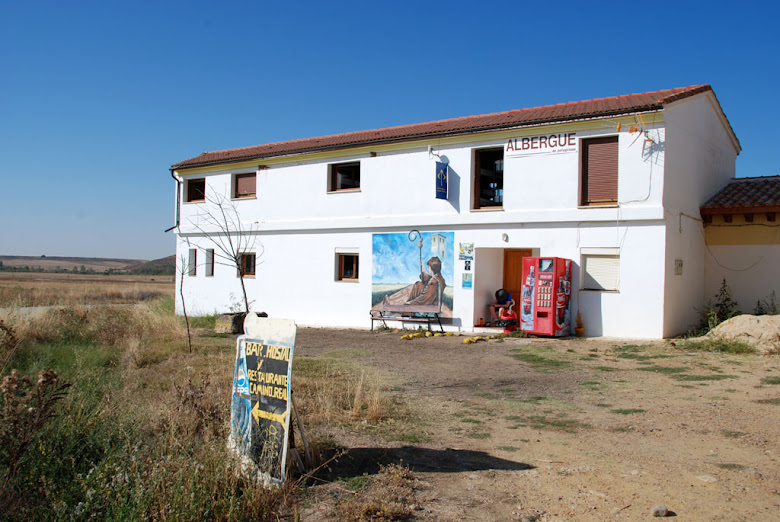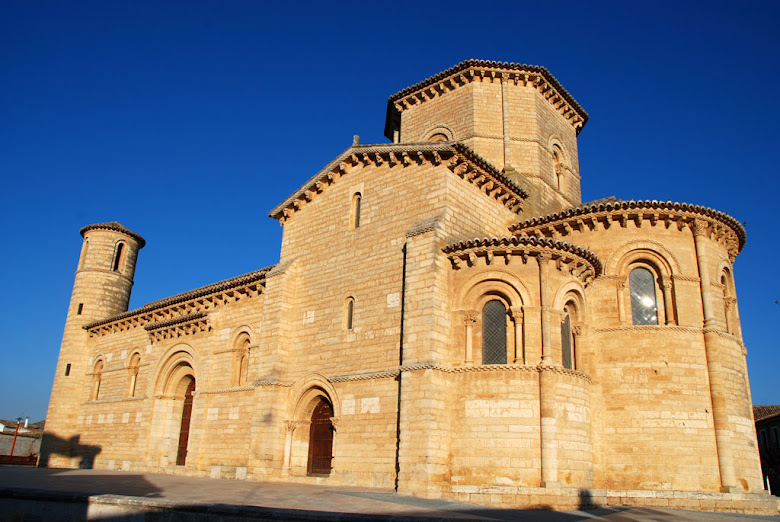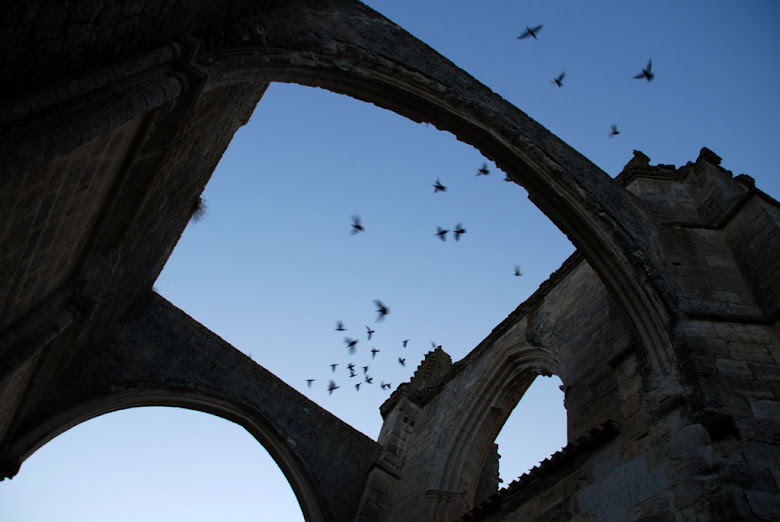Distance: 26.8km (446.1km).
Altitude (start / end / highest): 860m / 805m / 880m.
Weather: Nice, some veils on the sky.
It was not long between the ups and downs on this day, but at least I had slept well during the night. To Mansilla de Las Mulas, the walk was even more monotonous than the long section between Carrion de Los Condes and Calzadilla de la Cueza a couple of days ago, but the dinner in Mansilla more than made up for it. The dry plains of the meseta still contains its charms.
In the morning out from Bercianos del Real Camino, the Camino going on a senda in the blue light of the morning.
Went out in the early twilight, with a sky far more bluish than usual. It was probably a good thing that I started so early today and so reducing what quickly could have became an even more duller walk. In the morning hours, the increasingly blue light created a nice atmosphere on the Camino after Bercianos del Real Camino. It felt like it was only me and the desolate plains around me, though it was not exactly so. On the map in the guidebook, the Camino to Mansilla de Las Mulas appears almost like a straight line.
Laguna Olmo, a wetland reservoir next to the Camino. A bird observatory was erected next to the lake, where one can get in and look at the birds without scaring them away.
The best part of this day was over after the sun had been visible on the sky for a short time. The nice start in the morning hours was followed by the wetland reservoir Laguna Olmo. I arrived at the small lake probably at a perfect time, with the sun just on the rise. Next to the reservoir, there was a small bird observatory that I could go into. I could see the sunrays riding across the water. Should have stayed longer at this peaceful small oasis. Short after, the dust took over.
A small pond outside El Burgo Ranero. The name of the small village is as taken directly from a western movie.
Following after two French pilgrims after the bird observatory, I went wrong, but a local Spaniard guided me back on track. In Spanish though. Later on, I saw Martina taking the wrong turn in a large roundabout the Camino crosses over; I managed to yell across the noise from the cards and got her back on track again.
The long and dry senda out of El Burgo Ranero, the Camino goes where the trees goes.
In the air, I could vaguely hear the theme song from the For A Couple Of Dollars-movies, in the wind a low whistling tune. A closer feeling of riding into a western-town, I have never had, except of course that I walked on foot and is located far away from the wild west. That was however how it felt coming to El Burgos Ranero, the name immediately giving associations to the wild west. El Burgo Ranero, could have been a small border town between Mexico and the states that Clint rode through.
Looking at a cross through an agricultural sculpture just outside the village of Villamarco.
The albergue at the place is dedicated to an Italian pilgrim from the seventeenth century named Domenico Laffi and is built of brick and straw, it is rumoured to be a good place. It has not opened yet when we walk past it, so we did not get any opportunity to check it out. We had a short break in a local bar before we continued. Fortunately, no gunfight broke out in the street while we were there. A quiet whistling sound is heard from afar when we left the village.
A ruined cross on the long and boring walk between El Burgo Ranero and Reliegos, perhaps it had bored itself apart.
I survived the boredom of the 17 kilometre long stretch two days ago, but towards the end of the long senda following El Burgo Ranero, it barely held. This section was not as long as the mentioned section after Carrion de Los Condes, but this one actually felt longer. The only small highlights was some curious agricultural sculptures nearby Villamarco and the shady grove that I ate lunch at. The joy was thus high when I saw the houses of Mansilla de Las Mulas appear, only to be disappointed when it turned out to be Reliegos.
I had to have a beer in Reliegos.
One of the elaborate street signs in Mansilla de Las Mulas.
In Mansilla de Las Mulas, the walk into the small town was just as eventless as before, Alessandra and Martina sat and waited for me in the municipal albergue. They were in Reliegos and I had continued walking before them. Then it becomes clear that they had taken the bus into the town, the sneaky ones. The albergue has the appearance of a labyrinth; to find my allotted bunk, I had to walk crisscross inside of it. There were otherwise a nice little backyard.
This was how my boots looked like after many and dry days on the meseta.
Mansilla is not a large town, but it fits well as a sign of what awaits us tomorrow. Leon. It is nice with a slow transition to a larger place. Walking in the town felt uplifting after this day's tedious trudge. The name Mansilla comes from Mano en Silla (meaning the hand on the saddle) and de Las Mulas (meaning of the mules), so here we walked in the streets of the hand on the saddle of the mules. The old medieval city walls were maybe what I found most interesting. On the walls, there are remains of old towers; and you can climb up on top of some of them, from where you can scout out from and over the town.
Tower on the city wall of Mansilla de Las Mulas.
The best dinner on the Camino so far was the one we ate here in Mansilla. We were recommended a restaurant by the hospitalero at the albergue, which was far from a bad advice. The food was delicious and cheap. To us it felt like a gourmet meal. The menu was given verbally and that lead to some amusing small problems. Since I could not understand everything, everyone tried to help me. So, I got the menu explained in German, French, Italian, Spanish and English. All at once. I was more confused after, than before.
The best dinner on the Camino, this was the starter or primero.
Even with the somewhat dull part after El Burgo Ranero, I was relatively satisfied with the day. The day had indeed started great, especially with the visit to Laguna Olmo, and it indeed ended great with the gourmet dinner her in Mansilla de Las Mulas. To me, the adventure on the Camino still lives on. And I enjoy the feeling, the feeling that it is just me, me and the lonely plains around. The Meseta.
<- Bercianos del Real Camino























































